Caspak is a Big Place
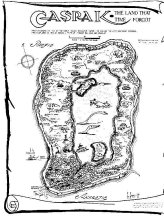
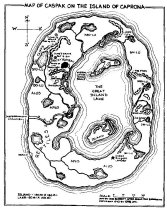
Before we can do anything with population density, we need to get at
least a ballpark figure for the area of Caspak. From the point where the
U-33 entered, it is about a 55-60 mile sail to the inland sea. From Fort
Dinosaur, on the coast of that sea, it is a 25 mile hike west to the cliffs.
The inland sea is about 60 miles wide at the point that Billings lands
at … but he says it would be a 300 mile journey "around the northern end"
to return to the cliffs where the Toreador party waits. The sea must be
oblong, longer north-south than east-west; let's say 150 by 60 miles.
Assuming Caspak is roughly symmetrical around the inland sea, we have
a 60 mile wide land margin north and south and 25 miles east-west. This
comes out to about 270 x 110 miles; somewhere in the ballpark of 30,000
square miles, about the size of Ireland (31,520) or Hispaniola (29,530).
This is a major island. Of course, we should subtract the area of the inland
sea and Oo-oh, as all this land is going into supporting Wieroo. Say 20,000-24,000
square miles.
This means that there is probably no problem with Caspak supporting
dinosaur-sized animals. The biggest dinosaur we see in Caspak are Diplodocus,
in the 12-15 ton range; the 30-50 ton sauropods don't seem to be present.
Sri Lanka has Asian elephants, and it is comparable in size to Caspak,
but much less fertile. (Caspak is continually described as vastly more
fertile than any other land on Earth).
Population Figures
We get precious few direct clues
to the Caspakian population of hominids (for convenience, I'm using “hominids”
to mean anything on the Caspakian evolutionary chain from apes to Galus
and cos-ata-lu). So most of this will be inference and guesswork.
Apes and Alus
In the early attack on the U-33,
more than five hundred show up; these are almost all apes and Alus, with
two or three Bo-lus present also. So there must be a very significant number
of apes and Alus, and they must be pretty dense, for such a number to gather
quickly.
In the real world, apes seem to have a population density (measured
by counting nests) of somewhere between 0.2 and a little less than 1 per
square kilometer – roughly, 0.5 to 2 per square mile. Assuming 1/square
mile, 500 apes would occupy a circle with a radius of about 12 ½
miles. This doesn't sound too bad: but certainly not all the apes
and Alus in the area would participate! It's stated that “all were
males”, for one thing, and probably only the more aggressive males would
have showed up. So we're talking an awfully large area for news of the
U-33 to travel so swiftly among ‘speechless’ creatures.
But here's where Caspak's exceptionally productive ecosystem steps in
again. In the hyper-fertile environment of Caspak, where wildlife is insanely
abundant, why shouldn't that hold true for apes too? “The south end of
the island fairly swarms with the Ho-lu, or apes”, so let's go all-out
and say 3 to 5 per square mile.
And what percentage of the land is occupied by apes and Alus? Let's
shelve these ‘lowest’ stages for a while; we'll come back to them later.
Bo-lu, Sto-lu, Band-lu
Here the data are even worse.
We never see the home life of the Bo-lu, but the other two gather in tribes
numbering several dozen, up to maybe a hundred or so.
These live a hunter-gatherer lifestyle. In the real world, hunter-gatherer
densities are low: according to A Concise History of Population
by Massimo Livi Bacci [the first credible-looking source I could find],
they vary from less than 0.01/sq km in the Arctic to about 0.43/sq km in
subtropical savannas. So the highest real-world ones are about 1/square
mile. However (stop me if you've heard this before) Caspak's hyper-productive
environment, larger population, yadda yadda. Let's say 2-3/square
mile.
Kro-lu, Galu
Here is where settled lifestyles
begin to appear. The Kro-lu and Galu both have domestic animals. (Considering
the fact that we are told that the higher stages of evolution are much
less numerous, I am not sure what drove the development of domestication
among the Kro-lu and Galu; it seems that there would never be a lack of
meat for hunters! Perhaps it was the desire to avoid the dangers of predators
encountered on a hunt, though it seems that the attraction to predators
presented by a herd of livestock would more than counterbalance this advantage.)
Their population densities thus could be higher, but we are told
that the higher races are "far weaker numerically." So, if we can get a
good figure here, this could get us a lower bound on the other types' population.
The Kro-lu village ruled by Altan comprises "several hundred" huts,
each with either a single person or a couple. So there is somewhat more
than 1 person per hut; let's say a total population of 500. This still
gives us no idea of the number of Kro-lu villages, but there is more than
one; since Al-tan is called "chief of the Kro-lu of the east," there must
be at least one other group of Kro-lu. If we assume that there is one other,
the Kro-lu of the west ("Galus come up from both the west and east coasts"),
this gives us about 1,000 Kro-lu. The Galus outnumber the Kro-lu, the only
higher race to outnumber the step below, since the Galus do not lose individuals
to further evolution. Let's say 1500-2000 Galus, then; probably closer
to the upper end, since they seem to lose a lot of women to the Wieroo
without seriously damaging their population. (Of course, those are cos-ata-lo,
a small minority and one with a lower reproductive rate than the others!)
How Large is Each Type's
Country?
Well, each country seems to
be about three days’ travel, sometimes less, to pass through. A "good day's
march" in Caspak is said to be about ten miles, so between twenty and thirty
miles per country, plus the coslupak (uninhabited areas) between them.
The coslupak are probably fairly narrow bands; let's say that after the
inland sea, islands, and coslupak are excluded, we're left with 20,000
square miles. Each country, assuming they are of equal size, would then
be about 3,000 square miles: but it seems that the Ho-lu and Alu do not
have clearly defined countries, but inhabit the rather large area south
of the inland sea which is heavily dinosaur-ridden. A larger area for these
types would make sense, since they are supposed to have a larger population.
For ballpark figures, let's say 5000 sq mi of good habitat for Alu and
Ho-lu combined, and 2000 sq mi for the other types.
So, Back to the Lower
Levels
So, our "minimum" is 1000, since
the Kro-lu are the least numerous. Each level is a noticeable step down,
so all the lower levels must be several thousand at least…
Rough Figures
Ho-lu: 9,000-15,000
Alu: 7000- 8000 ("slightly fewer in number than the Ho-lu")
Bo-lu: 4000-5000
Sto-lu: 3000-3500
Band-lu: 2000-2500
Kro-lu: 1000
Galu: 1500-2000
Total (Hominids on Evolutionary Chain): 26500-37000, let's say 30,000
So, this makes the average hominid population density of Caspak about
1.5/square mile – better than real-world hunter-gatherers, but not absurdly
so.
'Birth' and Death Rates
Well, I suppose it's not really
accurate to talk about ‘birth’ rates for most Caspakians…
An odd feature of Caspakian demography is that, excluding the rarer
cos-ata-lo, any addition to one group means a subtraction from the group
below. So, we can see (for a first approximation, excluding cos-ata-lo)
the entire hominid population as a single unit of about 30,000.
The question is, how many ‘come up from the beginning’ into hominid-hood,
and how many die out of it?
We see Caspakian natives eaten by predators or killed in intertribal
warfare repeatedly, so the death rate must be pretty high. We see
Al-tan's village suffer deaths from routine hunting, and we only are shown
one hunt! So let's say such a village, 500 individuals, loses someone every
week: that's 1 in 125 in a month, or a little over 1 in 10 in a year. At
1 in 10, that would mean 3000 apes "come up from the beginning" each year,
which would imply that they spend only three or four years as apes. Considering
that we see "risings" several times in the stories, a relatively brief
period in each stage would seem to fit; however, there is one cryptic mention
of the seven cycles required to bear a cos-ata-lu child as seven hundred
years. This refers to the full cycle (egg to Galu), and while it might,
it need not imply a longer period in each stage: after perhaps forty years
heading toward Galu, one could live sixty years as a Galu and become old,
to fill out the hundred years of a cycle.
While the numbers above are totally conjecture, it's clear that there
is a vast death rate from violent means: the Kro-lu village of Al-tan has
huts with couples, and single women, but no lone men. If the population
is so skewed toward women, this means far more men are dying in hunting,
combat, etc.
Saving the Worst for Last:
The Wieroo
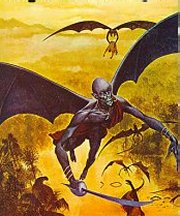
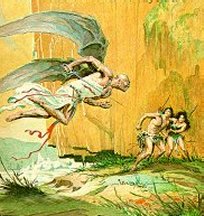
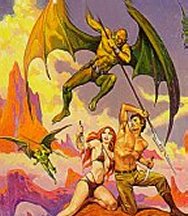
The Wieroo are a problem. They have three cities. Now, food supply is
probably not a problem, since they have herds of animals on Oo-oh which
are at least somewhat managed, and they eat fish (some are seen in the
Wieroo 'dining hall'). The inland sea swarms with life, so the Wieroo probably
have as much fish as they need.
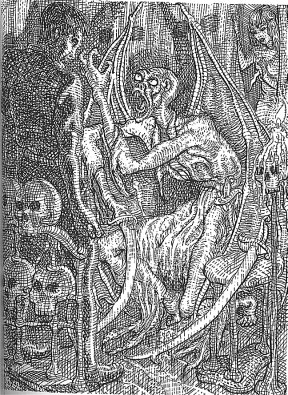 But
the Wieroo need Galu cos-ata-lo women to reproduce (having no females of
their own). These cannot be very numerous, since they are a definite minority
among the Galu – probably only a few hundred, at most. However, it does
seem that a high proportion of them end up in the hands of the Wieroo.
If we assume that 50 women are on Oo-oh at a time, there will probably
not be more than 50 Wieroo born in a year. Even if the Galu cos-ata-lo
population can sustain the loss of sufficient women to keep up a population
of 50 of them in Oo-oh (to make up for the doubtless high losses in childbirth),
the Wieroo cannot be all that numerous. They have a tremendous death
rate from murder, after all, and children are not exempt. I'm sure
Burroughs never actually thought this one out, but let's see if we can
make it work anyway…
But
the Wieroo need Galu cos-ata-lo women to reproduce (having no females of
their own). These cannot be very numerous, since they are a definite minority
among the Galu – probably only a few hundred, at most. However, it does
seem that a high proportion of them end up in the hands of the Wieroo.
If we assume that 50 women are on Oo-oh at a time, there will probably
not be more than 50 Wieroo born in a year. Even if the Galu cos-ata-lo
population can sustain the loss of sufficient women to keep up a population
of 50 of them in Oo-oh (to make up for the doubtless high losses in childbirth),
the Wieroo cannot be all that numerous. They have a tremendous death
rate from murder, after all, and children are not exempt. I'm sure
Burroughs never actually thought this one out, but let's see if we can
make it work anyway…
If the total population of Wieroo is 3000 (1000 per city) and a Wieroo's
life expectancy is 30 (it can't be too long, given the murder rate),
there must be 100 Wieroo born per year. This would probably mean at least
200 women. And how many abductions can the Galu cos-ata-lu population withstand?
On the other hand, the number of abductions depends on the life expectancy
of the mothers once they reach Oo-oh. If it is pretty long (say, 20 years)
that's 10 abductions/year: depending on the rate of population turnover
in the Galus, this might actually be possible, since it seems that many,
if not most, cos-ata-lo get stolen.
I'm still not comfortable with its working, really: but I'm sure Burroughs
never sat down and did the math. So this is the best we can do…
Livestock without Crops?
Interestingly, among both the
higher hominids on the Caspakian mainland and the Wieroo we see raising
of meat animals, but no farming of vegetable or grain crops. We know Caspak
does have plants of the proper type: the U-33 castaways at Fort Dinosaur
found a giant variety of maize. My speculation would be that in the immensely
biologically productive, frost-free environment of Caspak, with no winter
to keep insect numbers down, the pest problem would be prohibitive – even
if a woolly rhinoceros, plant-eating dinosaur, mastodon, etc. didn't decide
to eat your crops.
Or, of course, it could simply never have been invented – either because
no one thought of it, or it wasn't followed up because of lack of need.
We see no starvation among Caspakians, and the people's diets seem heavily
meat-oriented, so probably there is always enough wild plant food for the
people's needs. (Oo-oh, being a small area with a more concentrated population,
might be different; the Wieroo do eat fruits and vegetables, but it's not
clear in what proportion; and there is always much more plant food in an
environment than animal food, so there still might not be an issue.)


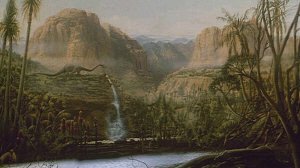
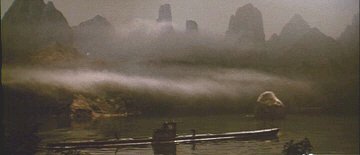
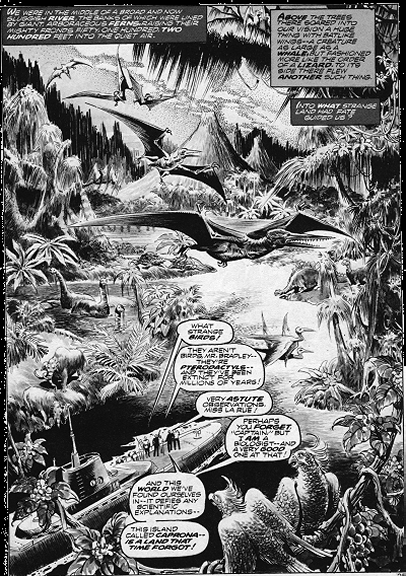
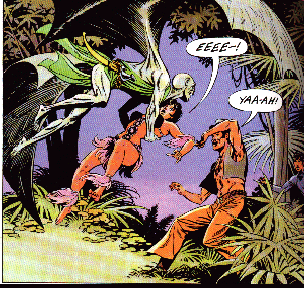
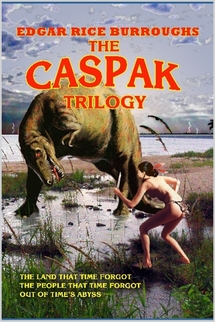
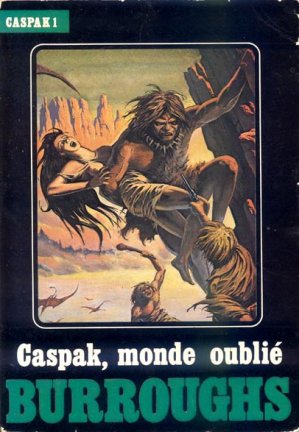
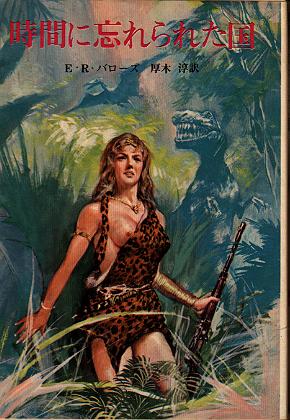
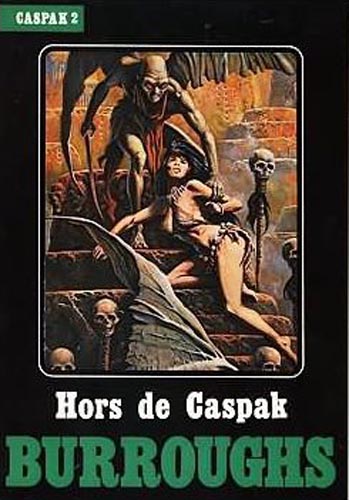
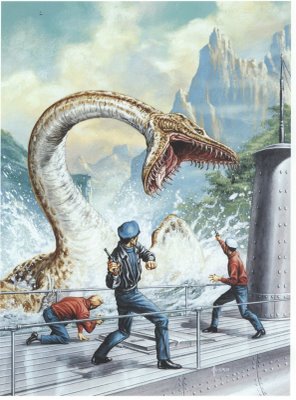
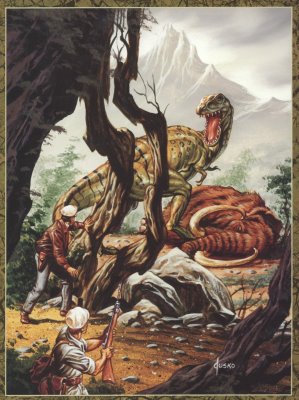
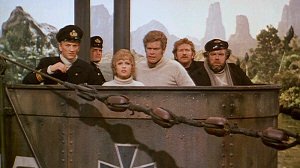
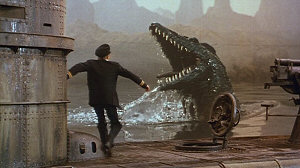
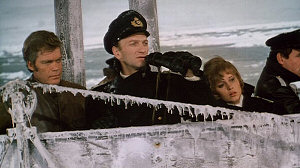
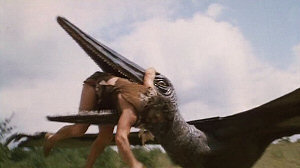
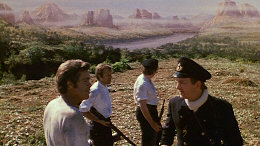
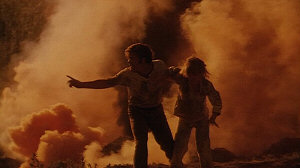
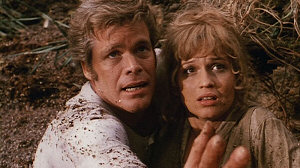
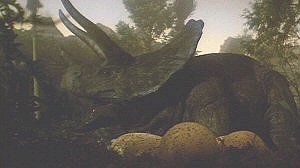
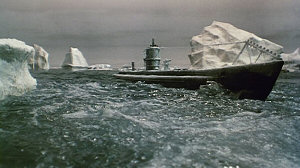
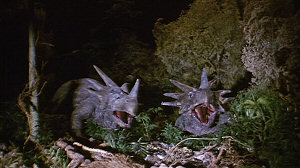
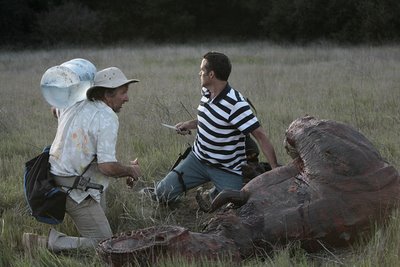
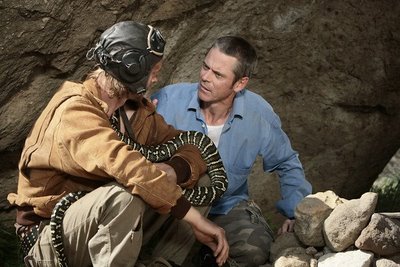
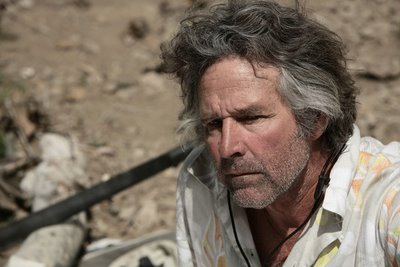
![]()

![]()

![]()
